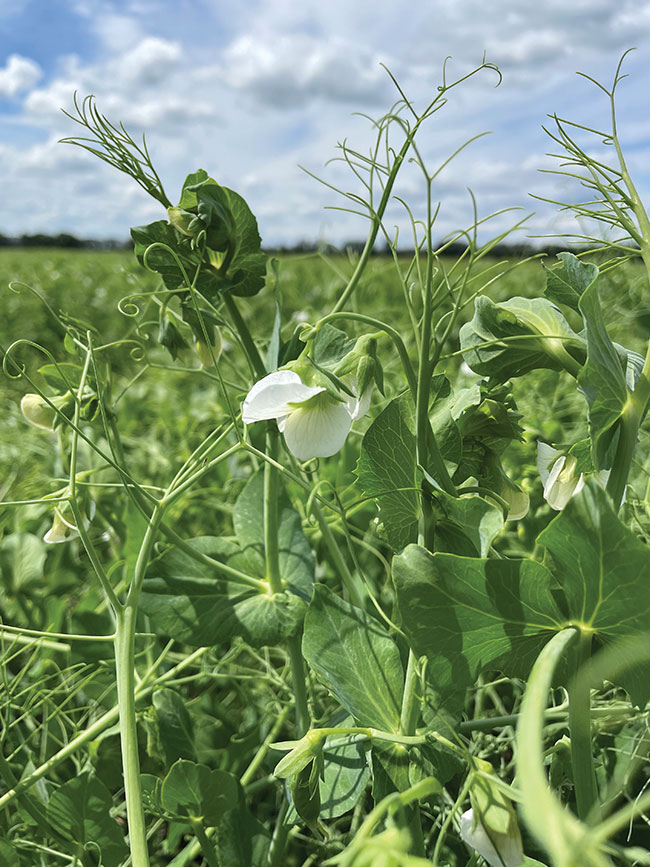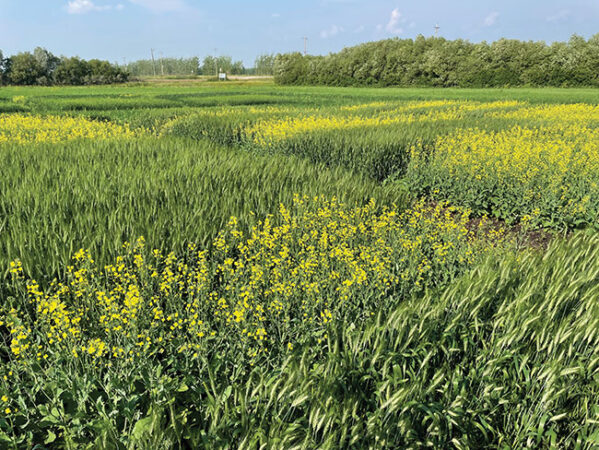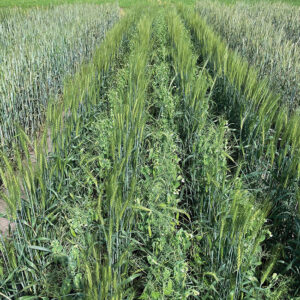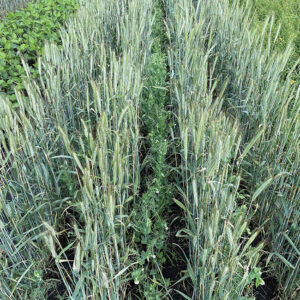
Features
Pulses
Improving productivity and profitability of pea production in Manitoba
Pea response to preceding crop, residue management and P fertilizer.
June 7, 2023 By Donna Fleury
 Yellow peas.
Photo credit for all photos: Kristen MacMillan, University of Manitoba.
Yellow peas.
Photo credit for all photos: Kristen MacMillan, University of Manitoba. New opportunities and recent strategic investment into pea protein facilities in Manitoba are increasing the demand for more local pea production. Although traditionally the majority of pea acres have been grown in Alberta and Saskatchewan, acres in Manitoba are on the rise. However, with limited pea production research specific to Manitoba, questions about best practices for improving productivity and profitability are being raised.
“We have initiated applied research projects in Manitoba to identify best management practices for profitable pea production,” says Kristen MacMillan, research agronomist with the University of Manitoba. “One of the studies initiated in 2020 is to test three agronomic practices including crop sequence, residue management and phosphorus (P) fertilizer use and placement in yellow peas. Currently, these practices vary widely among growers and there is no local research informing how these practices affect pea yield, quality and profitability. This project is being conducted over three years at Roblin and Carman, Manitoba.”
In Manitoba, peas are typically grown on wheat or canola stubble, with about 30 per cent grown on wheat stubble and 35 per cent on canola stubble. Legumes can fix their own nitrogen and are also fairly dependent on mycorrhizae for P uptake. MacMillan notes that canola, which is a non-mycorrhizal crop, can reduce mycorrhizae colonization on the following crop and negatively impact P availability and potential yield.
“We are also studying the effect of crop residue management by comparing peas seeded into tilled versus direct seed wheat and canola stubble,” says MacMillan. “Peas are tolerant to cool soil, which presents an opportunity for reduced tillage in our Manitoba cropping systems. As a result of recent years of drought and excess moisture, some growers are adopting rotational tillage and may alter tillage practices depending on the crop and moisture conditions.”
A third component of the study is a comparison of fertilizer P applications across the different treatments of wheat or canola stubble and residue management strategy. Peas have a fairly high requirement for P (a 50 bu crop removes about 35 lbs P2O5/ac) yet less than half of farmers across the Prairies apply P with their peas. This is likely a combination of variable yield responses and lack of information. This study is comparing pea response with and without starter P (standard rate of 20 lbs P2O5/ac) and placement method, either side band P or seed placed P. The experiments will assess the interactions of the agronomic practices and whether P response varies by crop stubble and/or residue management.
“We are in the middle of the project and do not have any results available yet. However, we are getting a good range of environmental conditions over the site years,” says MacMillan. “Some early field observations from 2021 did indicate clear visual differences in pea biomass during the vegetative stage at the Carman site, particularly to preceding crop, with greater biomass, canopy closure and canopy height in peas seeded on wheat as compared to canola stubble. It also looks like a yield advantage could be expected to direct seeded peas. We will have some better insights once we are able to analyze the data from year one and two, with preliminary results available in 2023. The study will be completed in 2024.”
A second longer-term study is also underway to look at the impacts of initial crop rotation in peas. Aphanomyces root rot is a significant disease of peas in Alberta and Saskatchewan, and some localized areas in Manitoba, with few management tools available. The key recommended management strategy remains long-term crop rotation, six to eight years if Aphanomyces has been confirmed.

Canola and wheat research plots seeded in year one, with yellow peas seeded in the stubble the following spring.
“In Manitoba, we have many farms growing peas for the first time, with production on fields that have no history of peas, and presumably low Aphanomyces. In these fields, we assume low levels of inoculum, so we may have a few years of low disease incidence, although soil moisture is also an important factor,” explains MacMillan. “With this unique position, I’m interested to determine how initial crop rotation frequency affects the buildup of Aphanomyces inoculum. I’m comparing a three-, five- and seven-year crop rotation starting in a field with no history of Aphanomyces at Carman. The long-term project just started in 2021, so we won’t have any observations for a few years.”
There is also growing interest in intercropping and relay cropping with peas to improve yield and quality. There are several projects underway in Manitoba, with a couple of projects led by the University of Manitoba. MacMillan has intercropping projects testing pea-canola, pea-oat and pea-flax. Another experiment is testing intercrops of peas with mustard and canola as a potential disease management strategy. MacMillan adds, one of the more novel experiments underway is relay cropping pea with winter crops. The relay crop combinations currently being evaluated are winter wheat, fall rye and winter camelina with yellow pea. The winter crops are seeded in the fall followed by yellow peas seeded early in the spring and the two crops are harvested together. Other priority research areas are seeding practices and fungicide disease management.
“In Manitoba, we want to help farmers build this crop cautiously and sustainably. My contribution to that is conducting local agronomy research and developing best management practices to optimize pea yield, quality and profitability,” says MacMillan. “In a lot of ways, where we are with pea production and agronomy today is where we were with soybeans 10 years ago. It’s old but new again in today’s cropping systems and environment that are continually changing. We won’t see the same growth we saw for soybean, but having local market opportunities and another grain legume for our crop rotation provides both economic and environmental benefits.”

